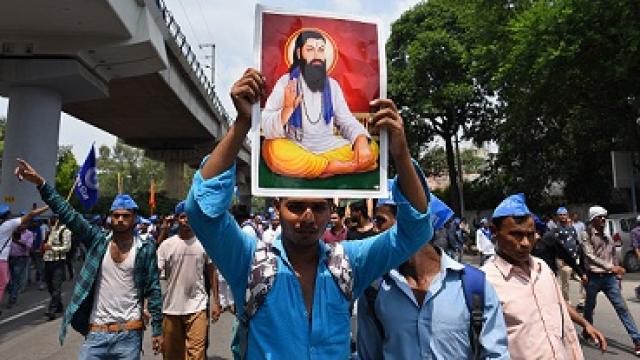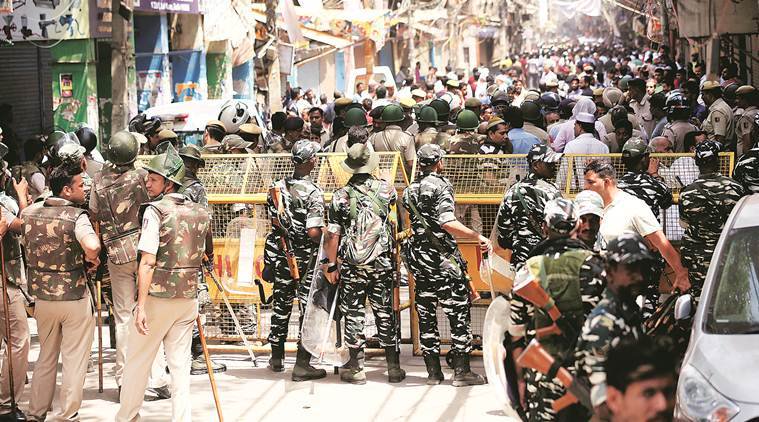
The medieval Dalit sage Ravidas often used the phrase ‘ Begumpura’ in his poetic compositions. By this phrase he referred to an idealistic land where pain or sorrow were unknown. Ironically, for many members of the Ravidasi community in Delhi’s Tughlaqabad, such a land has seldom existed in their lives.
Begumpura sear ko naau
Duke aidohu nah tihi thau
(My city is named ‘place of no sorrow, it has no distress, nor unhappiness)
Kahi Ravidas Khalsa Chamar
Jo hama seheri so mitu hamara
(Thus speaks Ravidas, the free Chamar. There every citizen is my friend)
With the temple of Ravidas being demolished by the DDA against their repeated pleas and a thorough denial of their right to worship, the community finds itself in a stage of both rage and helplessness.
The community stands in opposition to the DDA with regard to the ownership of the land on which the Ravidas temple once stood.
The sect claims that the particular piece of land was gifted to them by Sikander Lodi more than six centuries ago, the DDA however, looked at the plot as a hindrance to its developmental projects.
On August 9, the Supreme Court ordered the DDA to clear out the grounds while taking help from the police and demolish the temple.
The shrine was demolished the next day. The demolition of the Ravidas temple led to protests in Punjab(where nearly 10% of the population is Ravidasi)and in Delhi’s Ramlila Grounds.
On August 21, the Ravidasi sect called for a massive protest against the temple demolition in Delhi and a surprisingly large number of devotees came in support of the movement.
The devotees came from states like Punjab, Uttar Pradesh, Haryana and Madhya Pradesh. The protests marked the assertion of the Ravidasi community to not just reclaim its right to worship freely but also to demand for its right to living with dignity as part of the Dalit community.
From the Ramlila Maidan, many Ravidasi protestors moved to the site where the temple was demolished and the police had to resort to lathi-charge in order to control the protestors. Scores of people got arrested during the protest including the fiery head of the Bhim Army, Chandrashekhar Azad.
It is worth noting that the Ravidasi sect become overtly political and aware of its rights only during the 20th century.
The Ravidasi identity was stressed upon to assert Dalit rights during the Ambedkarite movement against caste oppression in India. The members of the Ravidasi sect are largely from the Chamar community and thus the celebration of being Ravidasis is a step towards political consolidation and assertion of an informed choice in politics.
It was Jagjivan Ram(a powerful Dalit leader from the 1970s)who was responsible for creating the Ravidas Mahasabha, an organisation for the people of the sect.
He is also credited for having built a Ravidas temple in Benaras.
Today, the Ravidasi sect claims that the site of the temple in Delhi’s Tughlakabad had been handed over to them by Sikander Lodi between 1489-1517.
Their version of the historic moment suggests that Saint Ravidas was jailed by Sultan Sikander Lodi on his arrival to Delhi. However, as soon as he was chained, the locks automatically disappeared and the Sultan realised that he had done wrong to a man who had divine powers.
He then became a bhakt of Ravidas and gave this piece of land to his followers.
It is to be noted that this story has been part of the Ravidas Ramayana, a modern-day biography of Saint Ravidas(first written in 1900)based on oral recollections.
Most of the Dalit protestors who joined in rebellion against the DDA’s move to demolish the temple, reiterated this story to add leverage to their struggle.
They claim that it is access to this story and its rationalisation that will add strength to their protest and help them challenge what they consider to be an ‘upper-caste controlled’ Indian state.
The assertion of the Ravidasi identity and the need to bridge the gap between folklore and history- together exemplify the fact that the struggle of the Dalit community is a long drawn one and that it must go on.
The Samajwadi Party chief Akhilesh Yadav has demanded immediate release of the Bhim Army Chief Chandrashekhar Azad and 90 others who were arrested after massive protests took place in Delhi against the demolition of the Ravidas temple.
The demolition of the Ravidas temple has quickly taken a political turn and many political parties are demanding that a new temple be built for the community at an alternative site or the same plot of land be given to the community for reconstructing the temple. It will remain to be seen how the nation-state engages in a negotiation with the Ravidasi community and ensures that their right to dignity and freedom of worship are not sacrificed.
It is an extremely significant moment in the history of the Dalit movement in India and will determine the pathways for future struggle for political determination and dignity for the Dalit community in the nation.












